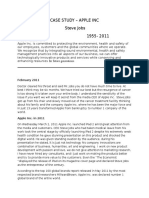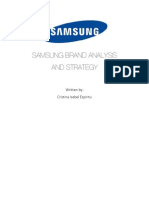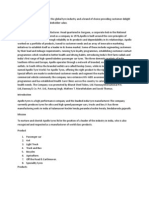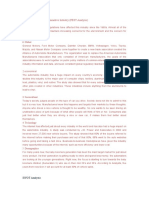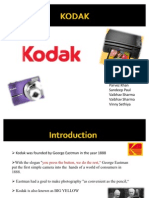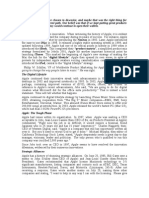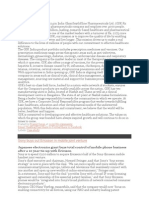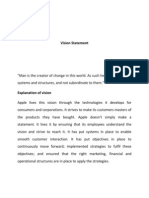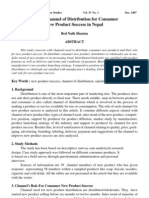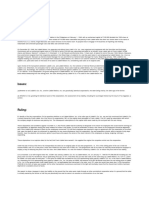Apple Assignment
Uploaded by
BikramKalsiApple Assignment
Uploaded by
BikramKalsiNATIONAL MANAGEMENT PROGRAMME (NMP)
STRATEGIC FORMULATION AND IMPLEMENTATION | PROF VEERESH SHARMA
APPLE ASSIGNMENT
SUBMITTED BY: SIMRAN KAUR KALSI (30NMP42)
Strategic Formulation and Implementation | Prof Veeresh Sharma
TABLE OF CONTENTS
MicroEnvironment ........................................................................................................................................ 2
Company ................................................................................................................................................... 2
Suppliers.................................................................................................................................................... 3
Marketing Intermediataries ...................................................................................................................... 3
Competitors .............................................................................................................................................. 3
Close Competitors ................................................................................................................................. 4
Loose (Fitness) Competitors ................................................................................................................. 4
Customers ................................................................................................................................................. 4
Macro environment ...................................................................................................................................... 5
Economic ................................................................................................................................................... 5
Ecological .................................................................................................................................................. 5
Technological ............................................................................................................................................ 6
Political ...................................................................................................................................................... 6
Government .............................................................................................................................................. 7
Barrier to Entry ............................................................................................................................................. 8
Time and cost of entry .............................................................................................................................. 8
Knowledge and Technology ...................................................................................................................... 8
Product Differentiation and Cost Advantage ............................................................................................ 8
Government Policy and Expected Retaliation .......................................................................................... 8
Access to Distribution Channels................................................................................................................ 9
Threat of Substitutes..................................................................................................................................... 9
Price band ................................................................................................................................................. 9
Substitutes performance .......................................................................................................................... 9
Buyers willingness ..................................................................................................................................... 9
Competitive Rivalry ..................................................................................................................................... 10
Bargaining Power of Suppliers .................................................................................................................... 11
Bargaining Power of Buyers ........................................................................................................................ 11
COnclusion .................................................................................................................................................. 11
Works Cited ................................................................................................................................................. 12
Apple Assignment | Page 1 of 12
Strategic Formulation and Implementation | Prof Veeresh Sharma
WHAT IS YOUR ASSESSMENT OF APPLE
WATCH?
The next revolution is in the wearable technology. Apple Watch is a personal electronic device that
combines the watchOS user interface and technologies created specifically for a smaller device, including
the Digital Crown, a unique navigation tool that allows users to seamlessly scroll, zoom and navigate, and
Force Touch, a technology
that senses the difference Apple Watch
between a tap and a press and
allows users to access controls
within apps. Apple Watch
MicroEnvironment
enables users to
communicate in new ways
from their wrist, track their
health and fitness through
MacroEnvironment
activity and workout apps,
and includes Siri and Apple
Pay. In September 2017, the
Company introduced Apple
Watch Series 3, featuring
health and fitness
enhancements and built-in cellular capability on qualifying devices. (Apple Inc., 2017)
MICROENVIRONMENT
Microenvironment (Chand, 2017) is the Company
actors close to the company that affect its
ability to serve its customers.
COMPANY
Competit
Suppliers
The Company designs, manufactures and ors
markets mobile communication and media MicroEnviron
devices and personal computers, and sells a ment
variety of related software, services,
accessories, networking solutions and third-
party digital content and applications. The
Companys business strategy leverages its Marketin
unique ability to design and develop its own Custome g
rs Intermed
operating systems, hardware, application iaries
software and services to provide its
Apple Assignment | Page 2 of 12
Strategic Formulation and Implementation | Prof Veeresh Sharma
customers products and solutions with innovative design, superior ease-of-use and seamless integration.
(Apple Inc., 2017)
SUPPLIERS
Although most components essential to the Companys business are generally available from multiple
sources, a few components are currently obtained from single or limited sources. many components used
by the Company, including those that are available from multiple sources, are at times subject to industry-
wide shortage and significant pricing fluctuations. (Apple Inc., 2017)
Since apple is an innovator, many times its components are available from a single source as the market
for it has not matured. The risk of delay and low quality is very high. Substantially all of the Companys
hardware products are currently manufactured by outsourcing partners that are located primarily in Asia,
with some Mac computers manufactured in the U.S. and Ireland. (Apple Inc., 2017)The manufacturing
cycle typically lasts 150 days.
MARKETING INTERMEDIATARIES
The Company sells its products and
resells third-party products in most of
SALES
Direct
its major markets directly to Distribution
consumers and small and mid-sized 28%
businesses through its retail and
online stores and its direct sales force.
They also have indirect distribution
channels, such as third-party cellular
network carriers, wholesalers,
Indirect
retailers and value-added resellers. Distribution
(Apple Inc., 2017) 72%
The Apple retail stores are its real competative advantage. Rather than just spaces designed to sell more
Apple products, the company is trying to foster communities in cities by providing free social spaces,
classes and meet-ups. (Apple Inc, 2017). There is an expansion of its retail stores worldwide and where its
possible a plaza is created where potential customers can relax, create, collobrate or just connect and
listen to concerts on weekends. Special focus is being given to education.
COMPETITORS
Apple Watch
$ 375 00
Apple Assignment | Page 3 of 12
Strategic Formulation and Implementation | Prof Veeresh Sharma
CLOSE COMPETITORS
Samsung Gear S3 Xiaomi
Iphone $359.99 $ 34 92
LOOSE (FITNESS) COMPETITORS
Pebble Fitbit Gramin
$ 79 90 $ 148 95 $398.96
Markets are characterized by frequent product introductions and rapid technological advances that have
substantially increased the capabilities and use of mobile communication and media devices, personal
computers and other digital electronic devices (Apple Inc., 2017). Principal competitive factors important
to the Company include price, product features (including security features), relative price and
performance, product quality and reliability, design innovation, a strong third-party software and
accessories ecosystem, marketing and distribution capability, service and support and corporate
reputation. (Apple Inc, n.d.). The competitors are highly competitive and include many large, well-funded
and experienced participants.
Competitors attempt to imitate some of the features of the Companys products. Apple Watch believes it
offers superior innovation and integration of the entire solution including the hardware. Some of the
Companys current and potential competitors have substantial resources and may be able to provide such
products and services at little or no profit or even at a loss to compete with the Companys offerings.
CUSTOMERS
There is only one valid definition of business purpose, that is to create a customer. (Drucker). The
Companys customers are primarily in the consumer, small and mid-sized business, education, enterprise
and government markets. Apple has always enjoyed a loyal customer fan base which is one of its biggest
assets. There is a high percentage of customers who crave to buy every new model released. Apple Watch
however proves to be a luxory for them as all the function are already being performed by the phone. The
mobile device is a substitute to the Apple watch but the viceversa is not true. Also, for the watch to
function at its best iphone is already requried.
Apple Assignment | Page 4 of 12
Strategic Formulation and Implementation | Prof Veeresh Sharma
MACRO ENVIRONMENT
Macro environment (Chand, 2017) consists of six
Economic major factors. They are demographic, economic,
natural, technological, political and cultural
environment.
ECONOMIC
The Companys operations and performance
depend significantly on global and regional
MacroEnviron Ecologica
Political economic conditions. Uncertainty about global
ment l
and regional economic conditions poses a risk as
consumers and businesses may postpone
spending in response to tighter credit, higher
unemployment, financial market volatility,
government austerity programs, negative
Technolo financial news, declines in income or asset values
gical and/or other factors. (Apple Inc., 2017). In such a
scenario the Apple Watch becomes even more of
a luxury item with so many cheap competitors available.
Some of the common factors applicable to all industries are energy costs, conditions of mortgage markets,
unemployment problems, automation, problems with labor etc. All these factors highly affect spending
behavior of the consumer.
ECOLOGICAL
Apple is doing a lot towards its responsibility towards environmental sustainability. It can be seen as
follows: (Apple, 2017)
Apple Assignment | Page 5 of 12
Strategic Formulation and Implementation | Prof Veeresh Sharma
As far as apple watch is concerned, waste sorting is implemented on its assembly line. Apple watch final
assemble suppliers now have zero waste or green teams to support the environmental improvements.
TECHNOLOGICAL
Global markets for the Companys products and services are highly competitive and subject to rapid
technological change, and the Company may be unable to compete effectively in these markets. The
major problem is of outsourcing to Asian market where obviously there is a propriety leakage. The original
hard-earned technology of Apple is easily reproduced in generic brands especially Xiaomi, One Plus etc.
Also, its Apple iOS + Hardware Vs. The competitors hardware only as
POLITICAL
(KPMG, 2017)
Apple Assignment | Page 6 of 12
Strategic Formulation and Implementation | Prof Veeresh Sharma
GOVERNMENT
There are many problems which cannot be controllable by the company such as; geopolitical
uncertainties, war against terrorism, authority to work and health issues which can affect the sale of
Apples product worldwide. (Apple Inc, n.d.). There would be no tussle of Apple with the authorities
regarding the information sharing / phone unlocking as it was in the case of iPhone.
(Word Count 1082)
Apple Assignment | Page 7 of 12
Strategic Formulation and Implementation | Prof Veeresh Sharma
SHOULD APPLE GO INTO AUTOMOBILE
BUSINESS?
Porters 5 forces on Automobile industry (Grant, 2017)
BARRIER TO ENTRY
(http://www.essay.uk.com, n.d.) Although there a huge capital cost to limit the entry of any new entity
into the automobile. itis becoming easier for foreign automakers to enter the Domestic market.
Automobiles depend heavily on consumer trends and tastes. While car companies do sell a large
proportion of vehicles to businesses and car rental companies (fleet sales), consumer sales is the largest
source of revenue. Apple has to face none of the cash crunch as in 2017 its net income was $ 48,351
million.
TIME AND COST OF ENT RY
Time is most essential thing while launching a product in any market. Apple is already ploughing resources
into developing technology to control driverless vehicles as driverless car venture is the mother of all AI
projects (Hern, 2017).
KNOWLEDGE AND TECHNOLOGY
Apple is the pioneer in knowledge and technology with specifics in R&S. Therefore, here just money is
required which apple can spare plenty
PRODUCT DIFFERENTIATION AND COST ADVANTAGE
The new product has to be different and attractive to be accepted by the customers. Without a doubt
apple has never yet dissatisfied its users on aesthetics with its simple and minimalistic design.
GOVERNMENT POLICY AND EXPECTED RETALIATION
In this case since apple would be working on driverless and electric cars, the government would obviously
promote such a project. Some of the macroeconomics changes that affect the automobile industry.
Apple Assignment | Page 8 of 12
Strategic Formulation and Implementation | Prof Veeresh Sharma
ACCESS TO DISTRIBUTION CHANNELS
Having an auto distribution channel is a real challenge as apple would be new to this. Although it has
highly innovated the user retail store experience, having to sell cars there is a whole new cost of having
new real estate in the same store or opening new ones.
THREAT OF SUBSTITUTES
Cars itself prove to be a biggest threat to themselves as
there is a rise of environmental awareness. Countries in
order to decrease the carbon footprint, are imposing norms
like BSVI on automobiles. Also subsidizing or removing the
cost of public transport.
The higher the cost of operating a vehicle, the more likely
people will seek alternative transportation options. This
new renaissance of awareness is starting with the
developed world against traditional cars. Apple is already
far ahead in the Environment sustainability. So therefore
substitutes will be actually electric and hybrid cars in the
future. The success probability of them as follows. (KPMG,
2017)
PRICE BAND
The threat that consumer will switch to a substitute product
if there has been an increase in price of the product or there
has been a decrease in price of the substitute product.
(http://www.essay.uk.com, n.d.). Apple is already a
premium brand for many price insensitive customers. It is
most likely apple can please the product in the extra niche
category like Tesla as it has a similar brand value
SUBSTITUTES PERFORMANCE
This would be mostly related to the nascent electrical or
solar car segment. It is mostly expected that if apple comes
in, it will not only bring electric cars but also self-driving
ones.
BUYERS WILLINGNESS
Apple enjoys a very loyal fan base. 98 percent of the Fortune 500 and over 92 percent of the Global 500
employees were using iOS devices in their business. (Apple Inc, n.d.) They are the most niche customers
who will definitely be willing to buy. Also in US they are allowed to drive in the fast lane with the electrical
engine which saves a lot of time which is highly precious to them.
Apple Assignment | Page 9 of 12
Strategic Formulation and Implementation | Prof Veeresh Sharma
COMPETITIVE RIVALRY
Highly competitive industries generally earn low returns because the cost of competition is high. The auto
industry is considered to be an oligopoly (A market condition in which sellers are so few that the actions
of any one of them will materially affect price) which helps to minimize the effects of price-based
competition. The automakers understand that price-based competition does not necessarily lead to
increases in the size of the marketplace (http://www.essay.uk.com, n.d.).
There is a huge competition even within the oligopoly.
Who has the Best prospects in the next 5 years (KPMG, 2017)
Apple Assignment | Page 10 of 12
Strategic Formulation and Implementation | Prof Veeresh Sharma
BARGAINING POWER OF SUPPLIERS
The bargaining power of suppliers depends upon the size and competitive advantage they have. Small
suppliers obviously have very less power where as the big suppliers have high power as they may have
some sort of monopoly in technology etc.
BARGAINING POWER OF BUYERS
It is pretty high because of the many options for the customers of all segments. Right from Tata Nano to
Tesla. Whereas electric vehicles are concerned, this power is less due to scarcity of supply and with
driverless cars even less. (KPMG, 2017)
CONCLUSION
It can be concluded that it is advisable that even if there are a lot of barriers to entry in the automotive
and, next generation technology i.e. driverless cars and hybrid / solar vehicles. Google stands to gain a lot
from here. Although they have lost a first mover advantage, but Apple knows how to sell products in mass
and will do the same for cars. This will benefit our environment in a great way, also reducing the accidents
with driverless cars. (Word Count 845)
Apple Assignment | Page 11 of 12
Strategic Formulation and Implementation | Prof Veeresh Sharma
WORKS CITED
1. Apple. (2017). Environment Sustainability Report.
2. Apple Inc. (n.d.). Retrieved from https://www.apple.com
3. Apple Inc. (2017, September 12). Apple Special Event. 12 September 2017. California, United
States of America.
4. Apple Inc. (2017). Annual Report Pursuant to Section 13 Or 15(D) Of The Securities Exchange Act
Of 1934. SEC, California. Retrieved from http://investor.apple.com/
5. Chand, S. (2017). Retrieved from http://www.yourarticlelibrary.com:
http://www.yourarticlelibrary.com/business/micro-environment-of-business-6-factors-of-micro-
environment-of-business/23370
6. Drucker, P. F. (n.d.). There is only one valid definition of business purpose, that is to create a
customer.
7. Grant, R. M. (2017). Contemporary Strategy Analysis, Text and Cases (8 ed.). Wiley.
8. Hern, R. D. (2017, June 13). https://www.theguardian.com. Retrieved from
https://www.theguardian.com/technology/2017/jun/13/apple-self-driving-car-technology-tim-
cook
9. http://www.essay.uk.com. (n.d.). Retrieved from UK Essay: http://www.essay.uk.com/free-
essays/business/porters-five-forces-model.php
10. https://www.target.com. (n.d.). Retrieved from https://www.target.com/c/apple-watch-series-
2/-/N-4skd1
11. https://www.theguardian.com. (2015). Retrieved from
https://www.theguardian.com/film/2015/nov/01/steve-jobs-the-afterlife-film-michael-
fassbender-danny-boyle-alex-gibney
12. KPMG. (2017). Global Automotive Executive Survey 2017. KPMG.
13. Yoffie, D. B., & Baldwin, E. (2015, October 25). Apple Inc. in 2015. Harvard Business School.
Apple Assignment | Page 12 of 12
You might also like
- Samsung Electronics Innovation and Design Strategy100% (1)Samsung Electronics Innovation and Design Strategy10 pages
- Strategic Management of Technology Plan For Apple100% (1)Strategic Management of Technology Plan For Apple14 pages
- Industry Analysis Case Study - STRAMA Group 5No ratings yetIndustry Analysis Case Study - STRAMA Group 519 pages
- Luminar-Leveraging Big Data Using Corporate Entrepreneurship"100% (1)Luminar-Leveraging Big Data Using Corporate Entrepreneurship"1 page
- How Samsung Electronics Creates, Captures and Delivers Value in The Smartphone Industry100% (1)How Samsung Electronics Creates, Captures and Delivers Value in The Smartphone Industry50 pages
- Performance Evaluation and Ratio Analysis of Apple IncNo ratings yetPerformance Evaluation and Ratio Analysis of Apple Inc18 pages
- Samsung Management Case Study: April 2020No ratings yetSamsung Management Case Study: April 202018 pages
- Apple Computer, Inc.:: Maintaining The Music Business While Introducing Iphone and Apple TV100% (1)Apple Computer, Inc.:: Maintaining The Music Business While Introducing Iphone and Apple TV9 pages
- Changing Business Environment of SamsungNo ratings yetChanging Business Environment of Samsung4 pages
- Strategic Analysis of Apple Inc.: Brian MasiNo ratings yetStrategic Analysis of Apple Inc.: Brian Masi35 pages
- Why Corporate Social Responsibility MattersNo ratings yetWhy Corporate Social Responsibility Matters11 pages
- Pibm PGDM 02 Pestel Analysis of SamsungNo ratings yetPibm PGDM 02 Pestel Analysis of Samsung10 pages
- Apple Environmental Progress Report 2024No ratings yetApple Environmental Progress Report 2024113 pages
- Social Media Plan - Phuong Trinh Le - 77315752No ratings yetSocial Media Plan - Phuong Trinh Le - 7731575234 pages
- Far Eastern University Manila, Philippines: Assignment inNo ratings yetFar Eastern University Manila, Philippines: Assignment in8 pages
- China Labor Watch's Report On Samsung Factories in ChinaNo ratings yetChina Labor Watch's Report On Samsung Factories in China124 pages
- The Association of Business Executives International Business Case Study Tesco Plc.No ratings yetThe Association of Business Executives International Business Case Study Tesco Plc.24 pages
- Company Electronics Appliances Semiconductors South Korea's: SamsungNo ratings yetCompany Electronics Appliances Semiconductors South Korea's: Samsung61 pages
- Mcdonald'S Market Entry Strategies: Global Strategic ManagementNo ratings yetMcdonald'S Market Entry Strategies: Global Strategic Management17 pages
- Factors Affecting The Automotive Industry (PEST Analysis)No ratings yetFactors Affecting The Automotive Industry (PEST Analysis)10 pages
- Exploiting The Business Potential of BYOD (Bring Your Own Device)No ratings yetExploiting The Business Potential of BYOD (Bring Your Own Device)12 pages
- Implementation of Mobile Technologies in OrganizationsNo ratings yetImplementation of Mobile Technologies in Organizations19 pages
- App Inovation Practice and Playbook - MSNo ratings yetApp Inovation Practice and Playbook - MS103 pages
- Group Assignment 2 - Ibs301m - Ib1705 - Group 2No ratings yetGroup Assignment 2 - Ibs301m - Ib1705 - Group 218 pages
- The Original Old-Fashioned Ice Cream Maker.: Owner'S Manual & Recipe GuideNo ratings yetThe Original Old-Fashioned Ice Cream Maker.: Owner'S Manual & Recipe Guide13 pages
- The Role of Recording Label in Today's Music IndustryNo ratings yetThe Role of Recording Label in Today's Music Industry10 pages
- Marketing Strategies Currently Used by FabindiaNo ratings yetMarketing Strategies Currently Used by Fabindia8 pages
- Marketing Notes 2-Marketing Channels of DistributionNo ratings yetMarketing Notes 2-Marketing Channels of Distribution8 pages
- Questionnaire: Name: Occupation: Contact No.: E-Mail Id.No ratings yetQuestionnaire: Name: Occupation: Contact No.: E-Mail Id.4 pages
- Role of Social Media Marketing in The Growth of Online StartupsNo ratings yetRole of Social Media Marketing in The Growth of Online Startups56 pages
- Discount_बट्टा_Discount_Practice_Sheet_With_Solution_MNo ratings yetDiscount_बट्टा_Discount_Practice_Sheet_With_Solution_M11 pages
- First - Namelast - Name Position Emailcompany - Name Executive - Linkedin Link Executive City Email Domain Method of Validation SMTP Server ResponseNo ratings yetFirst - Namelast - Name Position Emailcompany - Name Executive - Linkedin Link Executive City Email Domain Method of Validation SMTP Server Response6 pages
- Role of Channel of Distribution For Consumer New Product Success in NepalNo ratings yetRole of Channel of Distribution For Consumer New Product Success in Nepal6 pages
- A Study On The Customer Satisfaction and Customer Loyalty of Furniture Purchaser in On-Line ShopNo ratings yetA Study On The Customer Satisfaction and Customer Loyalty of Furniture Purchaser in On-Line Shop11 pages
- Samsung Electronics Innovation and Design StrategySamsung Electronics Innovation and Design Strategy
- Luminar-Leveraging Big Data Using Corporate Entrepreneurship"Luminar-Leveraging Big Data Using Corporate Entrepreneurship"
- How Samsung Electronics Creates, Captures and Delivers Value in The Smartphone IndustryHow Samsung Electronics Creates, Captures and Delivers Value in The Smartphone Industry
- Performance Evaluation and Ratio Analysis of Apple IncPerformance Evaluation and Ratio Analysis of Apple Inc
- Apple Computer, Inc.:: Maintaining The Music Business While Introducing Iphone and Apple TVApple Computer, Inc.:: Maintaining The Music Business While Introducing Iphone and Apple TV
- Far Eastern University Manila, Philippines: Assignment inFar Eastern University Manila, Philippines: Assignment in
- China Labor Watch's Report On Samsung Factories in ChinaChina Labor Watch's Report On Samsung Factories in China
- The Association of Business Executives International Business Case Study Tesco Plc.The Association of Business Executives International Business Case Study Tesco Plc.
- Company Electronics Appliances Semiconductors South Korea's: SamsungCompany Electronics Appliances Semiconductors South Korea's: Samsung
- Mcdonald'S Market Entry Strategies: Global Strategic ManagementMcdonald'S Market Entry Strategies: Global Strategic Management
- Factors Affecting The Automotive Industry (PEST Analysis)Factors Affecting The Automotive Industry (PEST Analysis)
- Exploiting The Business Potential of BYOD (Bring Your Own Device)Exploiting The Business Potential of BYOD (Bring Your Own Device)
- Implementation of Mobile Technologies in OrganizationsImplementation of Mobile Technologies in Organizations
- The Original Old-Fashioned Ice Cream Maker.: Owner'S Manual & Recipe GuideThe Original Old-Fashioned Ice Cream Maker.: Owner'S Manual & Recipe Guide
- The Role of Recording Label in Today's Music IndustryThe Role of Recording Label in Today's Music Industry
- Marketing Notes 2-Marketing Channels of DistributionMarketing Notes 2-Marketing Channels of Distribution
- Questionnaire: Name: Occupation: Contact No.: E-Mail Id.Questionnaire: Name: Occupation: Contact No.: E-Mail Id.
- Role of Social Media Marketing in The Growth of Online StartupsRole of Social Media Marketing in The Growth of Online Startups
- Discount_बट्टा_Discount_Practice_Sheet_With_Solution_MDiscount_बट्टा_Discount_Practice_Sheet_With_Solution_M
- First - Namelast - Name Position Emailcompany - Name Executive - Linkedin Link Executive City Email Domain Method of Validation SMTP Server ResponseFirst - Namelast - Name Position Emailcompany - Name Executive - Linkedin Link Executive City Email Domain Method of Validation SMTP Server Response
- Role of Channel of Distribution For Consumer New Product Success in NepalRole of Channel of Distribution For Consumer New Product Success in Nepal
- A Study On The Customer Satisfaction and Customer Loyalty of Furniture Purchaser in On-Line ShopA Study On The Customer Satisfaction and Customer Loyalty of Furniture Purchaser in On-Line Shop
















